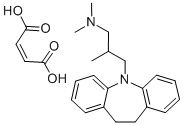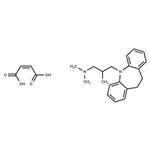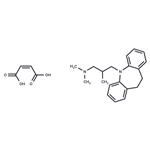Surmontil Wyeth-Ayerst,Laboratories
Antidepressant; serotonin transport blocker that also blocks norepinephrine uptake.
Antidepressant;Noradrenaline uptake inhibitor
Bis(3-dimethylamino-2-methylpropyl)-5-iminodibenzylyl carboxylic acid at
185-250°C up to discontinue a separation of oxyde carbonique. The product
was dissolved in ether, then washed with the hydrochloric acid. Then this
solution was extracted with ether. The solvent was evaporated under vacuum,
to give pure oil bis(3-dimethylamino-2-methyl-1-propyl)-5-iminodibenzyle with
boiling point 153-154°C at 0.4 mm. Maleate of bis(3-dimethylamino-2-methyl-
1-propyl)-5-iminodibenzyle have melting point 145-146°C.
For details of chemical nomenclature, consult the descriptionof imipramine. Replacement of hydrogen with an -methylsubstituent produces a chiral carbon, and trimipramine(Surmontil) is used as the racemic mixture. Biological propertiesreportedly resemble those of imipramine.
trimipramine (maleate) is a potent antagonist of histamine h1 receptor, serotonin 5-ht2a, and α1-adrenergic receptors [1].the histamine h1 receptor is widely expressed tissues, such as smooth muscles, vascular endothelial cells, heart, and the central nervous system. histamine h1 receptor (h1r) antagonists are very effective drugs alleviating the symptoms of allergic reactions [2]. 5-ht2a receptor shows constitutive activity. variations in5-ht2a receptor can produce profound alterations in cognitive states [3]. the adrenergic receptors play an important role in modulating sympathetic nervous system activity as well as a site of action for many therapeutic agents. the α1-adrenergic receptor is the prime mediators of smooth muscle contraction and hypertrophic growth. the α1-adrenergic receptor plays an essential role in smooth muscle, growth, neurological, and cardiovascular function [4].trimipramine (maleate) is a tricyclic antidepressant compound that antagonizes several types of neurotransmitter receptors. trimipramine potently antagonized the activity of histamine h1 serotonin 5-ht2a, and α1-adrenergic receptors with the kd value of 0.27 nm, 24 nm, and 24 nm, respectively. trimipramine moderately antagonized the activity of dopamine d2 with the kd of 180 nm. trimipramine inhibited the activity of muscarinic acetylcholine with the kd of 58 nm. trimipramine weakly inhibited the activity of 5-ht2c, d1, α2-adrenergic receptors (kd = 680 nm) [1]. trimipramine (maleate) was a weak to moderate reuptake inhibitor of serotonin (ki = 149 nm for sert), and an extremely weak inhibitor of norepinephrine (ki = 2.5 μm for net) and dopamine (ki = 3.8 μm for dat) reuptake in slices of rat cerebral cortex [5,6].
Antidepressant; serotonin transport blocker that also blocks norepinephrine uptake.
[1] richelson e, nelson a. antagonism by antidepressants of neurotransmitter receptors of normal human brain in vitro[j]. journal of pharmacology and experimental therapeutics, 1984, 230(1): 94-102.
[2] shimamura t, shiroishi m, weyand s, et al. structure of the human histamine h1 receptor complex with doxepin[j]. nature, 2011, 475(7354): 65-70.
[3] harvey j a. role of the serotonin 5-ht2a receptor in learning[j]. learning & memory, 2003, 10(5): 355-362.
[4] piascik m t, perez d m. α1-adrenergic receptors: new insights and directions[j]. journal of pharmacology and experimental therapeutics, 2001, 298(2): 403-410.
[5] gross g, xie x, gastpar m. trimipramine: pharmacological reevaluation and comparison with clozapine[j]. neuropharmacology, 1991, 30(11): 1159-1166.
[6] tatsumi m, groshan k, blakely r d, et al. pharmacological profile of antidepressants and related compounds at human monoamine transporters[j]. european journal of pharmacology, 1997, 340(2): 249-258.


